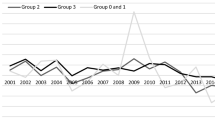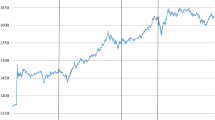Abstract
In this paper, we examine whether nominal stock price can help to explain the ex-dividend day anomaly where stock prices drop by less than the dividend amount on the ex-dividend date. We find that stocks with lower nominal prices have ex-dividend day price drops that are more consistent with theoretical predictions based on an efficient market. After controlling for factors that have been previously documented to influence ex-dividend day stock price behavior, price-drop-to-dividend ratios are closer to one for lower priced stocks. To further explore this phenomenon, we examine the change in the price-drop-to-dividend ratio around stock splits. Firms that split their shares have a larger price-drop-to-dividend ratio after the split, and companies that reverse split their shares have a smaller price-drop-to-dividend ratio after the split. Our evidence indicates that ex-dividend day stock price behavior is influenced by the nominal price of a share and that this relation could also influence the decision to split a firm’s shares.
Similar content being viewed by others
References
Angel JJ (1997) Tick size, share prices, and stock splits. J Finance 52(2):655–681
Asquith P, Healy P, Palepu KG (1989) Earnings and stock splits. Acc Rev 64(3):387–403
Baker H Kent, Gallagher PL (1980) Management’s view of stock splits. Financ Manag 9(2):73–77
Baker H Kent, Powell GE (1993) Further evidence on managerial motives for stock splits. Q J Bus Econ 32(3):21–31
Bali R, Hite GL (1998) Ex dividend day stock price behavior: discreteness or tax-induced clienteles? J Financ Econ 47(2):127–159
Boyd JH, Jagannathan R (1994) Ex-dividend price behavior of common stocks. Rev Financ Stud 7(4):711–741
Brennan MJ, Copeland TE (1988) Stock splits, stock prices and transaction costs. J Financ Econ 22(1):83–101
Campbell JA, Beranek W (1955) Stock price behavior on ex-dividend dates. J Finance 10(4):425–429
Chan K, Li F, Lin T-C, Lin J-C (2013) What do stock price levels tell us about the firms? Working paper
Chordia T, Roll R, Subrahmanyam A (2008) Liquidity and market efficiency. J Financ Econ 87(2):249–268
Chou RK, Lee W-C, Chen S-S (2005) The market reaction around ex-dates of stock splits before and after decimalization. Rev Pac Basin Financ Mark Polic 08(2):201–216
Dolley JC (1933) Common stock split-ups, motives and effects. Harv Bus Rev 12(1):70–81
Dubofsky DA (1992) A market microstructure explanation of ex-day abnormal returns. Financ Manag 21(4):32–43
Dyl EA, Elliott WB (2006) The share price puzzle*. J Bus 79(4):2045–2066
Eades KM, Hess PJ, Kim EH (1984) On interpreting security returns during the ex-dividend period. J Financ Econ 13(1):3–34
Eades KM, Hess PJ, Kim E (1994) Time-series variation in dividend pricing. J Finance 49(5):1617–1638
Elton EJ, Gruber MJ (1970) Marginal stockholder tax rates and the clientele effect. Rev Econ Stat 52(1):68–74
Fernando CS, Krishnamurthy S, Spindt PA (2004) Are share price levels informative? Evidence from the owner-ship, pricing, turnover, and performance of IPO firms. J Financ Mark 7(4):377–403
Francis JC, Wu TZC, Kuo N-T (2012) Effects of tax reform on drop-off ratios and on the ex-dividend and ex-right prices. Rev Quant Finance Acc 39(2):147–164
Graham JR, Michaely R, Roberts MR (2003) Do price discreteness and transactions costs affect stock returns? Comparing ex-dividend pricing before and after decimalization. J Finance 58(6):2611–2636
Green TC, Hwang B-H (2009) Price-based return comovement. J Financ Econ 93(1):37–50
Jakob K, Ma T (2004) Tick size, NYSE rule 118, and ex-dividend day stock price behavior. J Financ Econ 72(3):605–625
Kalay A (1982) The ex-dividend day behavior of stock prices: a re-examination of the clientele effect. J Finance 37(4):1059–1070
Karpoff JM, Walkling RA (1988) Short-term trading around ex-dividend days: additional evidence. J Financ Econ 21(2):291–298
Karpoff JM, Walkling RA (1990) Dividend capture in NASDAQ stocks. J Financ Econ 28(1):39–65
Kim S, Klein A, Rosenfeld J (2008) Return performance surrounding reverse stock splits: can investors profit? Financ Manag 37(2):173–192
Lakonishok J, Lev B (1987) Stock splits and stock dividends: why, who and when. J Finance 42(4):913–932
Lakonishok J, Vermaelen T (1983) Tax reform and ex-dividend day behavior. J Finance 38(4):1157–1179
Lakonishok J, Vermaelen T (1986) Tax-induced trading around ex-dividend days. J Financ Econ 16(3):287–319
Michaely R (1991) Ex-dividend day stock price behavior: the case of the 1986 tax reform act. J Finance 46(3):845–859
Michaely R, Vila J-L, Wang J (1997) A model of trading volume with tax-induced heterogeneous s valuation and transaction costs. J Financ Intermed 5:340–371
Muscarella CJ, Vetsuypens MR (1996) Stock splits: signaling or liquidity? The case of ADR ‘solo-splits’. J Financ Econ 42(1):3–26
So RW, Tse Y (2000) Rationality of stock splits: the target-price habit hypothesis. Rev Quant Finance Acc 14(1):67–84
Weld WC, Michaely R, Thaler RH, Benartzi S (2009) The nominal share price puzzle. J Econ Perspect 23(2):121–142
White H (1980) A heteroskedasticity-consistent covariance matrix estimator and a direct test for heteroskedasticity. Econometrica 48(4):817–838
Whitworth J, Rao RP (2010) Do tax law changes influence ex-dividend stock price behavior? Evidence from 1926 to 2005. Financ Manag 39(1):419–445
Author information
Authors and Affiliations
Corresponding author
Rights and permissions
About this article
Cite this article
Jakob, K., Whitby, R. The impact of nominal stock price on ex-dividend price responses. Rev Quant Finan Acc 48, 939–953 (2017). https://doi.org/10.1007/s11156-016-0574-0
Published:
Issue Date:
DOI: https://doi.org/10.1007/s11156-016-0574-0




